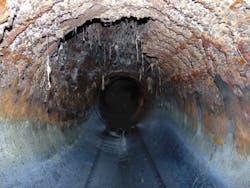Microbiologically Induced Corrosion
ConShield Technologies, 877-543-2094, www.conshield.com
A routine five-year inspection of a 36-in. reinforced concrete pipe (RCP) sewer interceptor in Rockland County, N.Y., Sewer District No. 1 revealed the top half of the interceptor, which had been in good shape just five years previously, was almost completely rotted out by microbiologically-induced corrosion (MIC). Even the reinforcing rebar was gone in 20 to 30 ft stretches of the 750 ln ft sewer; only solid root masses were holding the soil in place. Rockland has been implementing an aggressive inflow and infiltration reduction plan for several years that has reduced excess flows to their sewer plant by almost 50%. This is good, but reduced flows in this sewer may have allowed greater accumulations of organic matter, fostering growth of Thiobacillus bacteria and the consequent production of hydrogen sulfide and concrete-destroying sulphuric acid. And a failure in this 36-in. interceptor, just 1 mile upstream of the region’s wastewater treatment plant, would affect hundreds of homes and businesses.
Solution
After consulting with contractors Ace Pipe and National Water Main Cleaning, the district selected a centrifugally cast concrete pipe (CCCP) process known as CentriPipe to structurally rehabilitate the interceptor without digging.
Some creativity was needed to stabilize the pipe prior to spincasting. Following stabilization and dewatering, the crew worked from manhole to manhole, to apply a 1.5-in. thick concrete pipe in three 0.5-in. passes. To prevent future MIC damage, the high-strength fine-aggregate concrete liner (PL-8000 from AP/M Permaform) was mixed with ConmicShield, an additive that makes concrete intrinsically and permanently resistant to the formation of Thiobacillus bacteria.
Resolution
The Rockland sewer interceptor was repaired quickly, safely and cost-effectively, and the completed project is structurally sound and inherently resistant to MIC.
